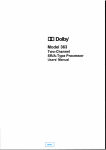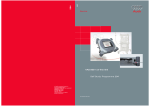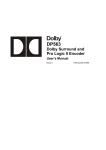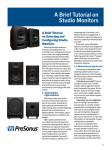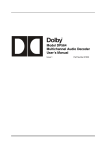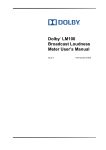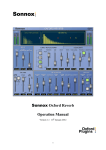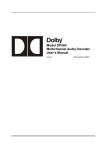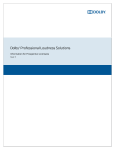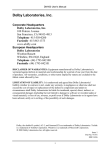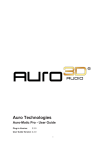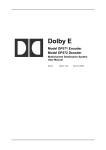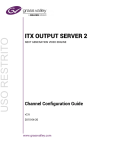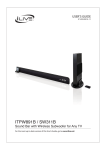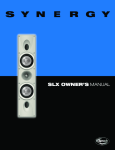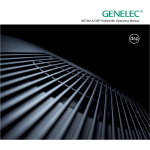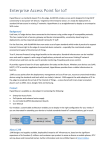Download Mixing Information for Dolby Pro Logic II
Transcript
Mixing Information for Dolby Pro Logic II Introduction With the introduction of discrete 5.1-channel mixing for DVD, satellite, cable, and HDTV applications, Dolby Laboratories developed the Dolby® Pro Logic® II matrix encoding system to allow a listening experience that more closely resembles the discrete 5.1channel mix when compared to the standard Dolby Surround encoding and playback system. This system allows content providers to deliver exceptional soundtracks to consumers who have not yet upgraded to the newer Dolby Digital home theater systems or are only able to play a program from a source with two channels of audio. This document discusses considerations for mixing with the Dolby Pro Logic II matrix. For technical setup information and operation of the Dolby DP563 encoder and DP564 decoder used in the creation of these mixes, please refer to the appropriate manuals supplied with the units. If the printed manuals are not available, they may be downloaded as PDF files from the professional audio section of the Dolby website at www.dolby.com. Technical Information Dolby Pro Logic II is a complementary encoding/decoding system. Although it is similar in design to the standard Dolby Surround system, there are significant improvements in the newer version. In addition to a much-improved steering action leading to more stable imaging, the surround channels are full bandwidth and stereo. This makes the system a 5-2-5 encoding system. It is completely backward compatible with the original Dolby Pro Logic decoder, so any program encoded in Dolby Pro Logic II will play back correctly on a Dolby Surround system. The output of the encoder is a stereo signal referred to as Lt/Rt. There is no obvious difference between an Lt/Rt signal encoded as Dolby Surround or Pro Logic II, and the signal can be treated as any conventional stereo signal for storage, transmission, and distribution. Discrete vs Matrix Mixing When mixing in the discrete 5.1-channel space, sounds always stay where they were originally placed. A sound panned to the Left Surround channel will always be in the Left Surround channel upon decoding; a sound placed in the Left and Right channels equally will stay in the Left and Right channels equally, and so on. If the sound in the latter example were to be sent to a Dolby Surround Pro Logic or Pro Logic II matrix encoder, however, the results would be very different. The matrix decoder responds to sounds originally placed equally in the Left and Right channels by directing them primarily to the Dolby Laboratories, Inc. 100 Potrero Avenue • San Francisco, CA 94103-4813 • Telephone 415-558-0200 • Fax 415-863-1373 Wootton Bassett • Wiltshire SN4 8QJ • England • Telephone (44) 1793-842100 • Fax (44) 1793-842101 Center speaker. This has been the case since the inception of Dolby Surround, and over the years production audio mixers have learned various methods to maintain the correct placement of sounds upon decoding. Problems also result when two very different and unrelated sounds are sent to two different channels at once. For example, crickets in the Surround channel and chickens in the front cause the sounds to bleed into the other channels, producing a dynamic image shift. This effect is distracting and undesirable. It is also common for a music track to contain a prominent lead instrument in the Left or Right channel while an announcer comes from the Center channel. The instrument appears to move from its intended speaker toward the center when the announcer speaks and then return to the correct position when the announcer stops talking. The solution is to either pan the music element toward center or temporarily reduce its level. Often, when producing motion picture sound effects, the sound effects designer removes all ambient sounds briefly so that another may be heard more prominently. For example, background sounds might contain a little traffic and night sounds at a fairly low, but definitely audible level. Then a doors slams loudly. At precisely the beginning of the slam, the ambient sounds are either mixed to a very low level or removed entirely. They are then quickly brought back to their original levels in the mix (even before the slam has ended), and consequently aren’t missed by the audience. Understanding the Encoder Processing Delay In the old days of analog encoders, shortcuts were sometimes taken and the Surround channel was encoded and externally added to the Left and Right channels. In most cases, this worked fine. With digital encoders, things are a little different. As with all digital processing devices, there is a small time delay between the input and output of the matrix encoder. Typically, this delay is about two milliseconds. Therefore, if the Surround encoded signal was treated the same as it had been in the analog realm, it would shift in time two milliseconds behind the Left and Right signals. The slight delay would cause flanging of any sounds common to the Left, Center, Right, and Surround channels. To prevent this from happening, all signals in the mix should be fed through the encoder. Starting with a 5.1 Mix The Dolby Pro Logic II encoding process was developed to allow consumers to enjoy a 5.1channel experience on delivery systems that have a two-channel limitation. Because of this, it was optimized for taking a 5.1 mix created for Dolby Digital delivery, and simply running that mix through the encoder to create the Lt/Rt stereo downmix. In most cases, the decoded Dolby Pro Logic II mix will sound very close to the original. Many broadcasters and content creators are successfully doing this on their projects, using the standard settings within the encoder; programs include classical concerts, live sporting events, and variety and awards shows with live studio audiences. Others have decided to have a little more fun with their 5.1 mixes, while scaling back a little on their matrix-encoded mixes. Action-adventure series and events like auto racing and are good examples of shows that allow for extra sound in the surround channels of the discrete mix. The Dolby Pro Logic II encoder has two menu-driven controls for optimizing the Dolby Pro Logic II downmix created from a 5.1 mix. The end user may choose to use none, one, or both of these controls. For mixes that need more center information (such as dialogue-heavy content), the Center Trim control allows you to increase the amount of Center-channel information in the output. Some content producers find that increasing this number from 0 to +2 or +3 provides satisfactory results. Others have decided to mix more aggressively in the surround channels for the 5.1 mix. Most consumers don’t complain when there is excessive content in their surround speakers when listening in discrete 5.1. However, those who are listening in stereo may have a difficult time hearing the dialogue when the surround channels are very active. To compensate for this, the Surround Trim control allows you to reduce the level of the surround channels. By lowering the level from 0 to –2 or –3, a satisfactory downmix can be realized for the viewer using Dolby Pro Logic II decoding, while keeping the 5.1 listener fully involved with more pronounced surroundchannel levels. The trim controls are there for your use. However, the mixer needs to realize that if a downmix is created within a Dolby Digital decoder, it will sound like the default settings of 0 center and 0 surround in most circumstances. The end audience requirements will dictate whether the overall mix requires correction or only the encoded Dolby Pro Logic II mix requires correction via the trim controls to achieve the desired results for all listeners. Typical Channel Content There are several approaches to mixing multichannel audio. Which approach is the right one depends on who you ask and what you prefer. Regardless of which approach is used, there are some basic channel assignments that most successful mixes are based on. The Left and Right channels contain music, ambience, and offscreen specific effects (such as a car door slamming beyond the range of the camera). Center contains dialogue, lead vocals, a small amount of ambient effects, and some music elements. Left and Right Surround channels contain ambient effects and ambient elements of the music. Occasionally you will hear offscreen voice effects, but seldom primary dialogue unless some of it is also in the front channels for mono compatibility. The Low-Frequency Effects (LFE) channel contains extra bass information necessary to make effects sound big enough. It should never contain elements that are not in other channels unless they are derived from sounds in the other channels (such as bass information connected to the music or effects in other channels). If LFE is used in a Dolby Pro Logic II mix, it must be enabled in the encoder. The default settings ignore the LFE-channel information. Dealing with Mono Sources Perhaps some of the most challenging elements for a Dolby Pro Logic II mix are those that arrive in mono. In some cases, these elements are destined for the Center channel and are simply sent there. In other cases, these mono sources are supposed to appear in several channels of the mix. Which channels are intended to carry the mono sources will help define how to properly get them to appear there when decoded. If you take a mono source and assign it to the Left and Right channels, it will appear in the Centerchannel output of the decoder. To get it out of the Center channel, it has to be time shifted in one channel (delayed) or synthesized using some external process that may include delay as part of the process. Delay times of around eight milliseconds will usually suffice. Stereo-synthesizing processes should be used with caution, and should be added only in enough quantity as to create the desired results or they can introduce other problems. Regardless of which process is used, it must be listened to through the decoder and it must be listened to in both stereo and mono to ensure it isn’t creating any undesirable artifacts. When using a stereo synthesizing process, it is normal to hear some of the signal through the surround channels. For signals that are intended to appear in the front and back channels simultaneously, you can usually just assign them there and, for the most part, they will stay there. Some elements, such as dialogue in the Center channel, may have an effect on how other mono elements react. A combination of delays and a stereo synthesizer may assist in creating the desired effect. Dealing with Stereo Sources Stereo sources, as well as premixed matrix-encoded elements within the mix, will be correctly processed by the decoder. These elements are generally assigned to Left and Right channels. The preencoded element will be decoded as expected, and a phenomenon known as “magic surround” will create the soundfield from the stereo element. Dolby Pro Logic II was specifically designed to take stereo elements and create surround soundfields from them in a pleasing way. Exactly how the elements are decoded will be affected by other elements within the mix. A given stereo element may sound fine by itself, but have problems when other elements are added to the mix. In these cases, tweaking the mix to compensate for the added elements and achieve the desired results may be required. This is also true of preencoded elements. While it is common practice to premix elements for a large or complex mix and utilize the surround encoder in the process, it is mandatory for the mixer to listen to the combined mix through a decoder with all of the elements present in the mix. Any change in levels, or additions and subtractions of signals in the mix, will affect how the decoder handles the signals. Occasionally, a stereo source may contain more surround information than is desired when it is decoded. This is particularly true of stereo keyboards and other devices that manipulate waveforms to achieve their signature sounds. In these instances, simply panning the stereo element away from hard left and right and bringing it toward the center will compensate for this problem. It usually doesn’t take much panning to fix the problem. Pots originally panned hard left and right probably won’t need to move past the 9 and 3 o’clock positions to produce pleasing results while maintaining the stereo image originally intended. This is further proof that mixes need to be monitored through a decoder to ensure that problems do not exist. Upmixing Issues The need to include stereo and other previously produced content into the 5.1-channel mixing environment sometimes necessitates a process commonly referred to as upmixing. In most cases, this means taking a stereo track and making it into five channels so that it blends well into the production. Because this five- or 5.1-channel mix will potentially end up as a stereo element again somewhere in the playback environment, care must be taken when upmixing. This is particularly important when making a matrix-encoded track with Dolby Pro Logic II. If upmixing is required, it should be done with zero delay in the surround channels. If delay is used in the surround channels of the device doing the upmixing, the subsequent Dolby Pro Logic or Pro Logic II decoder will not function as desired and the psychoacoustic principles used to enhance the process will not be realized. Whenever possible, upmixing should only be done for a 5.1 mix and any elements that are candidates for upmixing should remain as stereo for the Dolby Pro Logic II mix. If it is not possible to avoid the upmix process, it should only be done on the final mixing process to avoid multiple encode/decode generations, which produce undesirable steering artifacts. Center Channel Buildup One of the most difficult issues facing mixers is how to deal with a hard Center channel. Because so many mixers grew up with a phantom center, they have a hard time hearing it come from a dedicated speaker. Viewers, on the other hand, are becoming increasingly familiar with the sound coming from the three front speakers of their home theater setups. When mixing in a discrete format, it is easy to avoid the center speaker. You simply don’t assign any sounds to the Center channel. When it comes to matrix encoding and decoding, however, there isn’t any way to avoid it. In the matrix decoder, center is defined as equal amplitude and phase in the Lt and Rt signals, and therefore doesn’t differentiate between a phantom or hard center. If you take a single element like a vocal and pan it between the left and right speakers equally, it will appear in the Center channel output of the decoder. If you record a sound with two microphones in close proximity you will usually get a considerable amount of sound from the center speaker because of the commonality of the two signals. When the decoder is steering predominantly center it will tend to pull the other channel’s information to the center output. While the Dolby Pro Logic II matrix does a better job of separating signals than the previous Dolby Pro Logic decoder, there will still be some Center channel information in a mix. It is important to monitor the signals through a decoder to make sure that the center information is not overpowering, and to take corrective action if it is. Music Mode vs Cinema Mode Decoding Dolby Pro Logic II decoding has two listening modes: Cinema and Music. There are slight electrical differences in the output signals of the two modes. Cinema mode is very close to the standard Dolby Surround decoder, with the exception of the full-bandwidth stereo surrounds. Also, a polarity inversion of one of the channels is used to spread the signal in the room. Music mode is designed for playing back material that wasn’t originally encoded in Dolby Surround or Pro Logic II. There is no polarity inversion in the surround channels. The Dolby Pro Logic II Music mode also includes a feature named Center-channel divergence. This setting allows the end user to take all or part of their Center-channel information and redirect it to the left and right speakers. It is a very useful feature when playing back material that was not originally encoded in Dolby Surround or Pro Logic II. While the professional decoder provides this feature, there is no guarantee that a given listener is set up the same way. For this reason, monitoring in Cinema mode is the preferred method for mixing because the majority of users will listen to this mode. As mentioned earlier, even though you can spread the center information across the three front channels to the encoder, the decoder will put all of the common information into the center output. Compatibility with Dolby Surround, Stereo, and Mono Playback Systems When mixing in Dolby Pro Logic II, compatibility with other listening options must be considered. Listeners who are using older Dolby Surround Pro Logic decoders will hear very little difference in their mix. The front channels will be virtually identical. The major difference is that they will hear a mono Surround channel with very little information above 7 kHz for that channel instead of the fullbandwidth stereo surround signals in the mix. In most cases, mixes created with both the original Dolby Surround encoder and the new Pro Logic II encoder are fully interchangeable with either Dolby matrix decoder within the limitations of the respective systems. In addition to home theater viewers with matrix decoders, mixers must also account for viewers listening to stereo and mono speaker setups. This includes people watching TV in their bedrooms, dens, RVs, and other places where Dolby Pro Logic II decoders aren’t practical or desired. Because of this, it is important to listen to the mix in both stereo and mono to make sure the mix is acceptable for these setups. This is especially true if the mix is derived from a discrete 5.1 mix. While it might sound complicated, it usually isn’t difficult to produce a mix that translates well to all setups. Signal Processing Issues There are several devices on the market that are 5.1 friendly. Reverb units, limiters, pitch correctors, and delays are now designed to be used with 5.1-channel mixing. The majority of the devices used for processing will work with Dolby Surround and Pro Logic II, as well as with discrete 5.1-channel Dolby Digital. Whatever process is selected for a particular production, it is important to monitor the results through the decoder in both stereo and mono downmix modes to ensure the effect is not creating undesirable artifacts in those listening modes. Once the content is encoded into an Lt/Rt signal, it should not be subjected to additional signal processing unless absolutely necessary. If there is no alternative, the output of the process should be monitored and decoded to be sure that the process is not destroying the encoding. Any stereo processing should be applied equally to both channels to avoid creating unwanted difference signals. This is especially true of limiters and compressors. If they are not properly linked and set up identically, the resulting decoded mix will shift from side to side and front to back with the action of the two separate limiting and compressing functions. Applying different delay or equalization to the two channels will destroy the phase encoding. Console Output Timing Issues With the widespread use of digital audio consoles and other digital processing equipment, engineers must now deal with the latencies inherent when using digital processing such as equalization, compression and limiting, and so on. Many console manufacturers have realized this and automatically compensate for the delay on every channel. Other manufacturers have taken a slightly different approach to the issue; rather than compensate for channels individually, they have grouped functions and outputs, and compensate for the delay at the bus outputs. Many consoles utilize the grouped delay idea on their outputs, but separate them so that auxiliary buses are not necessarily in the same time domain as the multitrack or monitor buses, or the main mix outputs. Unfortunately, this means that you need to feed everything from a single group in consoles designed this way. This is certainly the case when feeding a Dolby Pro Logic or Pro Logic II encoder. Uncorrected latencies cause phase-shift errors, often resulting in a noticeable phase shift and accompanying level shift at higher frequencies. Cancellation can occur at specific frequencies because the existing surround phase shift combined with the latency offset results in signals with inappropriate opposite polarity. High-end consoles may have several timing modes available for a group of outputs; these allow you to use separate groups of outputs to maintain correct timing. Consult your console user manual if you are having timing issues. Dealing with LFE Signals In a typical 5.1 downmix the LFE signal is not used. This is true for every Dolby Digital decoder ever built into a consumer product. When the DP563 was designed, the option of including some of the LFE signal was included. However, it needs to be restated that there is no LFE channel provision in the Dolby Pro Logic II matrix. Once the information from the LFE channel is added in, the decoder processes it as Center channel information, or information common to Left and Right channels. In order for the LFE information to get to a subwoofer on playback, the consumer decoder needs to be using bass management and redirecting bass information to a subwoofer. There are other concerns when adding an LFE signal to the mix. If the LFE is simply redistributed within the other channels of the mix, they will usually be subject to some low-frequency bandpass filtering. This filtering causes phase shifts of the LFE signal. When they are acoustically added within a room, these phase shifts are fairly subtle and often go unnoticed. However, when they are electronically added together with the five main channels in the encoder, they may produce less than desirable results at certain frequencies. For this reason, it is recommended that the LFE signal not be used in a Dolby Pro Logic II downmix unless it contains unique information that is not repeated in any of the five main channels. Microphone Placement and Techniques There are multiple techniques for capturing multichannel sound, and several products are on the market that are intended specifically for this purpose. All of these devices were designed with a particular application in mind. Some products excel at capturing a five-channel experience from a single point with a self-contained unit. Others include multiple elements and DSP processing to further enhance the image. An issue common to techniques using a single point source is borne from the physical placement of the microphone elements. Because they are in such close proximity to each other, they tend to pick up a considerable amount of common information. For a discrete playback system this isn’t usually an issue. However, for a matrix-encoding system, it is a primary concern. Since the matrix is looking for information common to both front channels in order to create the Center-channel information, this common information will build up to the center speaker. The resulting sound is usually far more forward focused in the soundfield and is reproduced predominantly by the center speaker. Another solution is to use spaced microphones to create Left, Right, Left Surround, and Right Surround signals. Using one microphone in each channel will create a soundfield that is acoustically coupled, while maintaining a considerable amount of isolation in each channel. The venue or space to be captured determines the optimal spacing for the microphones. Large stadiums or arenas, for instance, lend themselves to considerable spacing between microphones, while smaller venues require closer spacing. Even 20 feet of separation between the microphone elements will create a better matrix-decoded effect than with microphones that are close together. This issue also comes up when stereo microphones are used. When a stereo microphone is the only reasonable option for a given situation (such as when using a microphone mounted on a handheld camera), delaying one side of the stereo microphone by eight to ten milliseconds may help to create a better sound image. This is equivalent to a spacing of about ten feet between the two microphone elements. Depending on the source being picked up, the use of delay may or may not sound acceptable. If possible, use two microphones physically spaced as far apart as possible, as physical placement is always preferred over electronic simulation and processing. Dolby, Pro Logic, and the double-D symbol are registered trademarks of Dolby Laboratories. © 2005 Dolby Laboratories, Inc. All rights reserved. S05/16186









